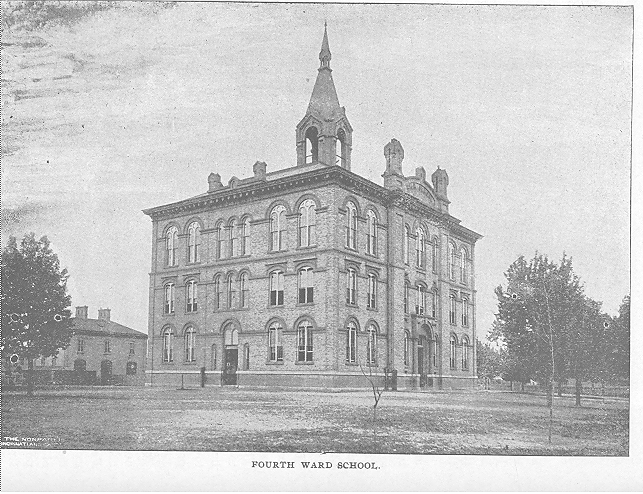
THE CENTENNIAL ANNIVERSARY OF HAMILTON, O. - 201
originally devised for Akron but made applicable to such other municipalities as might adopt it. This law was the beginning of the Ohio system of graded schools. In the Autumn following the adoption of the Akron law, the work of grading and classifying the schools began.
In 1854 the union of Hamilton and Rossville was made. The schools were united in one system at the beginning of the following year.
Since that date no material changes have taken place. The private schools have disappeared, but the Parochial schools more and more divided the work of public education.
MIAMI UNIVERSITY.
MIAMI UNIVERSITY, situated at Oxford, Ohio, chartered in 1809, opened as an Academy in 1816, and with a full Collegiate Course in 1824, is the most famous educational institution in Butler county.
The endowment consists of the rental of the lands of Oxford Township, an educational gift from the United States. Three of the buildings were erected out of the endowment fund, The chapel was the gift of the Alumni and friends of the school, and the Scientific Hall was the gift of Senator Calvin S. Brice, an alumnus, and the most liberal friend of the school. Its scientific apparatus and its library of 11,000 volumes furnish important aids in the work of education.
From 1824 forward through fifty years, this school did a great educational work. It has been. repeatedly stated, that in proportion to the number of its pupils, it furnished more men of note and influence, than any other school in the United States.
Owing to lack of funds, it was closed in 1813 and remained closed until 1885, during which time its debts were paid and a considerable endowment fund accumulated.
It now has a gross income from rents, tuition fees, and interest of more than ($10,000) Ten Thousand Dollars, and in recent years the state has adopted the policy of making moderate additional apportions for the care and maintenance of the buildings, grounds, apparatus, &c.
This school has always been noted for the soundness of its education. It has adhered to the usual course of college study, holding as its guide : "We do a few things well." The results so far have vindicated the practice of the University.
Among men prominent in political affairs she counts : Rob. C. Schenck, Samuel Shellabarger, Governor Morton Governor Charles H. Hardin, Gov. ernor Lowe of Iowa, Win. S. Groesbeck, Governor Chas. Anderson, Governor McRae of Mississippi, Geo. E. Pugh, Senator Calvin S. Brice, President Harrison and many others.
Among the distinguished editors she counts : John J. Harney, James J.
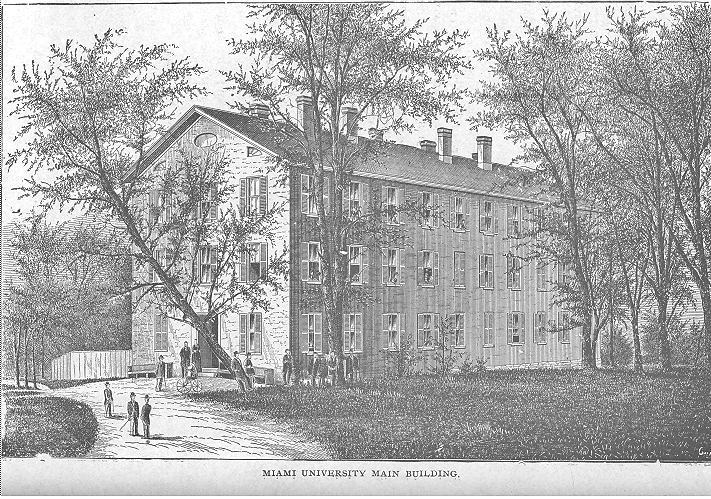
THE CENTENNIAL ANNIVERSARY OF HAMILTON, O. - 203
Farron, Whitelaw Reid.
Among eminent clergymen we find: Dr. Thomas E. Thomas, Thornton A. Mills, Benj. W. Chidlaw, Jos. G. Monfort, Jas. H. Brooks, David Ewing and Chancellor Henry M. McCracken.
At this time the attendance of students is steadily increasing, and everything indicates that the school will recover its old time standing. The work of instruction is performed by ten professors who are proficient in their work. While the University does not pretend to teach all that may be known in the world, it is thoroughly equipped for thorough instruction in more of the branches of learning than any student can master within the time allowed for school education.
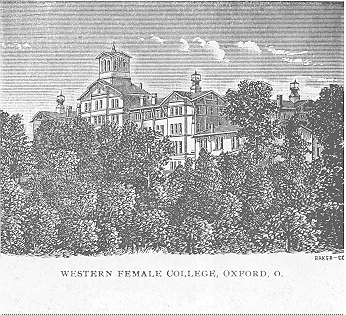

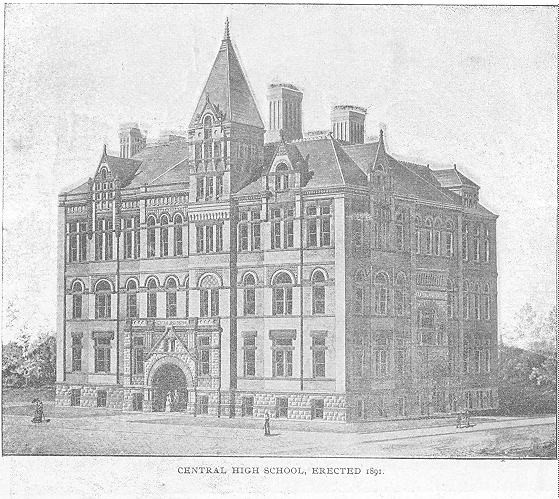
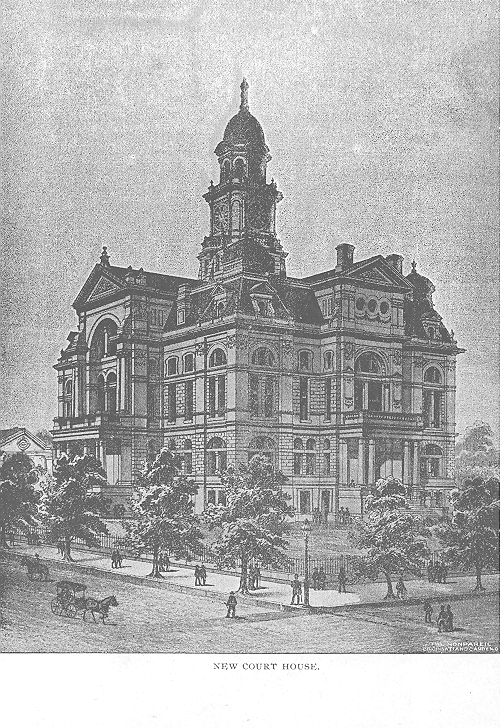
THE CENTENNIAL ANNIVERSARY OF HAMILTON, O. - 207
COURTS.
BY THOMAS MILLIKIN
THE history of the Courts of Butler County, to be properly written, would occupy more space than can be appropriated to the purpose in the volume proposed to be published as Hamilton's Centennial Souvenir, having in view the various matters claiming space in such a publication. Hence a brief statement of facts must suffice.
The County of Butler was formed by an Act of the Ohio Legislature in 1803, and the seat of justice established at Hamilton upon report of James Silvers, Benjamin Stites and David Sutton, commissioners appointed by the Legislature to select a location for the county seat. Several enterprising parties sought the location of the county seat on property owned by them,—notably Wm. McClellan and Geo. P. Torrance who owned the land on the northerly side of the Miami River opposite the Hydraulic Headgates, some four miles tip the river from Hamilton and by Jacob Burnet, John Sutherland and others composing a company who owned the land on the west side of the Miami River opposite Hamilton and now comprised in the first ward of the city.
Isreal Ludlow, proprietor of the town plat of Hamilton proposed to the commissioners to donate one square in Hamilton to the county for church and burial purposes. It is the same square in the 4th ward now occupied by the beautiful Ludlow Park, and another square for public buildings, and to pay toward the erection of a Court House in money $200. The offer of Ludlow was accepted but he died in the year 1804, and before he had made conveyance of the property, Subsequently the administrators of his estate under authority of a decree of the Court of Common Pleas, completed the contract and made conveyance of the property to the county. and the same is now in use by the county for the purpose of public buildings and the Court House Park. After the establishment of County Butler in the early part of 1803, but before location of the permanent county seat at Hamilton, James Dunn, John Greer and John Kitchen by act of the Legislature had been appointed associate Judges, and they organized and held the first civil court ever convened in the county. The session began May loth, 1803, and was held in the tavern of John Torrence, situated on the corner of Dayton and Water streets. The same building is yet standing in a good state of preservation. It was the first frame building erected in Hamilton.

THE CENTENNIAL ANNIVERSARY OF HAMILTON, O. - 209
On Tuesday July 12th, 1803, the Court of Common Pleas of Butler County was organized and held in the same building. Francis Dunlevy was the Common Pleas Judge and presided, and with the above named associate judges constituted the court. John Reily was appointed Clerk, James Blackburn, Sheriff, and Samuel Dillon Coroner. Daniel Symmes officiated as Prosecuting Attorney. On October 11th, 1803, the Supreme Court of Butler County was organized and held in the same place. The judges were Samuel Huntington, William Sprigg and Arthur St. Clair, Jr., was prosecuting attorney. William McClellan (the first elected) sheriff, and John Reily was appointed clerk also of this Court.
The above Courts were organized under the Constitution of the State of Ohio adopted by the people in the year 1802.
Article III, of that Constitution provided that the judicial power of the State both as to matters of law and equity should be tested in a Supreme Court, in Courts of Common Pleas for each county, in Justices of the Peace and in such other courts as the Legislature might from time to time estab. lish. The Legislafure enacted laws establishing and defining the duties and powers of the Supreme Court, and Courts of Common Pleas, and Justices of the Peace, Courts of General Quarter sessions. Orphans Courts and perhaps other courts in other parts of the State. In does not appear that an Orphans Court was ever organized in Butler County. But a Court of General Quarter sessions was organized and at its session held May 10th, 1803, fixed and defined the boundaries of all the townships in the county. This Court did not cut much of a figure in the judicial business of the County and the law of its establishment was soon thereafter repealed. Its jurisdiction was limited and inferior.
From the establishment of the various Courts above mentioned in 1803, until 1809 John Reily who was Clerk of all these Courts and as well Recorder of the county, held his office in a small log building situated just outside of the south wall of the old fort and a short distance south of the present site of the United Presbyterian Church. The Clerks and Recorder's office were thence removed to the south room in the old Reily two story frame building on the east side of the public square and were continued there with Mr. Reily in office until the year 1824 when they were removed into buildings erected for their purpose in the Court House square, and there remained until removed into the commodious rooms in which they are now located in the Court House.
The Courts were held in the Torrence Tavern only one year and then were transferred to a frame building within the old fort which had been used by the officers of the garrison as a mess room. It was elevated upon wooden blocks some ten feet above the ground and furnished a very desirable shelter for hogs and other animals. The judges seat consisted of a platform con-
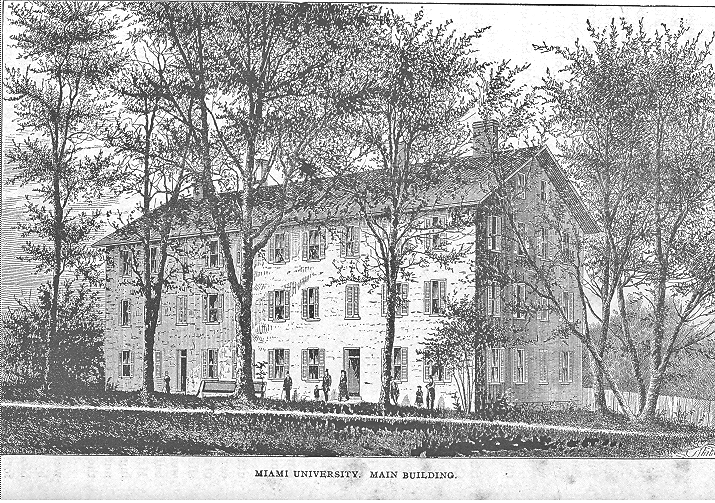
THE CENTENNIAL ANNIVERSARY OF HAMILTON, O. - 211
structed of unplaned boards. The old fort magazine building was used for a jail.
The first public building erected on the square was a jail. It was built of limestone obtained from the river, was 33 by 22 feet, two stories high and cost $1600 and was erected in 1806. The next year another stone building 33 by 30 feet two stories high was erected by the County Commissioners for the accommodation of the jailor at a cost of $1,690. The upper story of this building over the jailers apartments was fitted up for the Courts and the sessions of the various courts were held there from the year 1810 until the year 1817. This building is said to have been neither artistic in appearance or convenient in use.
On the l0th day of November 1813, the County Commissioners contracted with John E. Scott to furnish all of the materials and erect a brick Court House building according to plan and drawings furnished and to complete the same ready for occupancy in the year of 18r 6 for the sum of $9,000. Scott lost $1,000 on the contract. The Legislature passed a law authorizing the Commissioners to pay to him the $i,000 and which they did. The Courts were transferred to this Court House from the old stone building in the year 1817. The arrangement of the rooms in the building proving to be inconvenient and too small for the use of the county, the County Commissioners in the year 1836 contracted with W. H. Bartlett to remodel the building which was done according to plans furnished and at a cost of $15,919, and that building as remodeled was continued in use for the Court until torn down in the year 1888, to give place to the present commodious structure.
In the year 1820 the Commissioners contracted with Pierson Sayre to erect of brick two one-story office buildings in the square in a line with the front of the Court House at a cost of $2,486, and they were completed and occupied in the year 1822. In the year 1836 an addition was built to the one on the west side of the Court House and that building raised to two stories at a cost of $1500.
The next year the building east of the Court House had a similar addition annexed to it, and the structure raised to two stories at a cost of $1,820. The building east of the Court House was occupied by the Probate Court and County Clerk's offices and the one on the west side for the offices of the County Auditor, Recorder, Treasurer and County Commissioners.
Without further detail, suffice it to say, that these buildings afforded such conveniences for the Courts and public offices as were usual in other counties of the state, and were in the line of progress from those of the early pioneer days.
In the year 1885 an act was passed by the Ohio Legislature, authorizing the issue of $200,000 bonds of the county for the purpose of creating a fund and empowering the Commissioners of the county to erect a new Court House building, and providing for the appointment by the Judge of the
212 - THE CENTENNIAL ANNIVERSARY OF HAMILTON. O.
Court of Common Pleas of the County of a building committee of three freeholders to assist the Commissioners, Clerk, Sheriff and Probate Judge in the adoption of a plan and in the erection of the building. In the year 1887 another act of the Legislature was passed authorizing the issuing of an additional $90,000 of county bonds for the purpose of completing and furnishing the Court House. The money was all expended for these purposes. The building was erected and the structure is commodious, is well heated and ventilated, but it is not well arranged and adopted to the purposes for which it was erected. Its architecture is a half century behind the age. It is to be regretted that better judgement was not exercised in the adoption of a plan of. building. _______ Richardson of Massachusetts, the ranking architect of the world, at that time, condescended to furnish drawings tor the house, but his artistic accomplishments were so far beyond the intelligence and comprehension of a majority of the committee that his plan was uncontinently thrust aside in favor of the old time copy of other structures prophesied by the Toledo brick-layers. Hence the city of Hamilton has in its midst a combination of stone and other materials in ordinarily old-fashioned form, instead of a building that would have been a credit to the progress of the age, and a cause of pride and rejoicing on the part of our posterity at their centennial in 1991.
Under the provisions of the constitution adopted by the people in 1851, our Courts now consist of the Probate Court. the Common Please and Circuit Courts. The Supreme Court of the State is no longer perambulatory as in former days, but it is permanently held at the Capitol of the State. The bar as part of the Court is entitled to notice in this constitution.
William Corry was the first lawyer who opened an office in Hamilton. He is said to have been a man of ability, but he continued in the practice of his profession only a few years and then retired to a farm where he spent the remainder of his life. In the early days of this century many eminent jurists and lawyers attended the courts of this county. Amongst them, Judge David K. Este, Nicholas Longworth, Joseph S. Benham, Benjamin Callett, Ethan Stone, Thomas R. Rass and Judge John McLean. And at a later day John Woods, William Bebb, Thomas Cormie, Jesse Cormie, Elijah Vance, Ezekial Walker, John B. Weller, Lewis D. Campbell, Henry Stansberry. Then following judge Josiah Scott. Judge James Clark, N. C. McFarland, Thomas Moore and Thomas Millikin the latter three of whom are living and yet in the practice.
The members of the bar now residing in Hamilton and engaged in active practice, alphabetically arranged are: Allen Andrews, Benj. W. Baker, Edgar A. Belden, Philip G. Berry, M. O. Burns, W. 0. Campbell, Stephen Crane, P. C. Conklin, S. Z. Gard, William S. Giffen, F. T. Hammerle, R. P. Hargitt. E. E. Hull, Alex F. Hume, Ed. H. Jones, Henry L. Krauth, W. H. Harr, P. B. Holly, J. W. Meckley, B. R. Millikin, Thomas Millikin, Thomas
THE CENTENNIAL ANNIVERSARY OF HAMILTON, O. - 213
Moore, H. L. Morey, J. F. Morey, Clarence Murphy, James H. Neil, Jno. F. Neilan, W. L. Petree, David Pierce, Eugene C. Pociey, Isaac Robertson, W. C. Shepherd, John C. Slayback, Culla J. Smith, Jesse C. Smith, B. F. Thomas, F. VanDerveer, I. M. Warwick, Aaron Wesco, James P. Whitmore, Nelson Williams and Isreal Williams.
Whilst it is true that Courts are proverbially conservative, nevertheless in this progressive, pushing country they have in a measure to keep up with the spirit of the age. The demands of business methods cause the Courts to deviate from precedent and to keep in line with the general progress of events. Thus the charming simplicity and directness of the procedure of the Courts of the pioneer days. When principle was dominant in the findings and judgements of the Courts, has give way to circumlocution and subterfuge in many instances, to avoid the effect of a decision upon principle. Political and business influences cause the decisions of our Courts, oftentimes to be strained and artificial, instead of direct and natural as in the pione er days. But such abuses and improprieties it is thought will in due time correct themselves. It is to be hoped that such will be the case and that within the next centennial period our Courts may acquire such position as to command the. respect and reverence of the people.
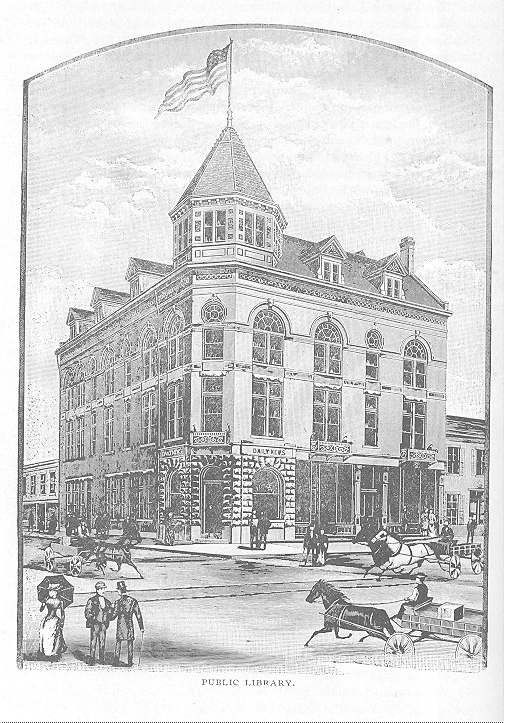
PART IV.
HAMILTON
- IN -
THE WAR, LITERATURE, STATESMANSHIP
AND POLITICAL INFLUENCE
HAMILTON, OHIO
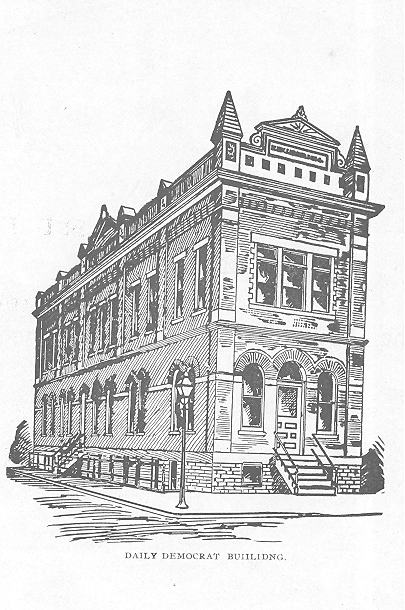
THE CENTENNIAL ANNIVERSARY OF HAMILTON, O. - 217
HAMILTON IN LITERATURE.
BY DR. MILLIKEN.
HAMILTON has at no time during the past Century period, been regarded in the light of a literary center—outside of the Schools and Academies, no organized efforts at literary accomplishments have prevailed, unless the ordinary debating and social clubs that now and then sprang up and after an emepheral existence disappeared, shall be regarded in that light.
The temporary corruscation produced in this manner can scarcely be said to have a place worthy of notice in comment on qualities of the pioneer literature or in the scholastic incubation that is suppposed to precede the birth of a literary spirit in the people.
Whilst it is true that a sufficiency of literary accomplishment has not existed to give the citizens of Hamilton the attributes usually deemed necessary to characterize the existence of a literary guild, it is true that the people who have lived in this community during the past hundred years, have many of them been possesed of considerable literary accomplishments and many of them have had lasting influence upon the minds of the people. Captain John Cleves Symmes author of the Theory of Concentric Spheres—(that is, that the globe is hallow and is inhabitable within)— as an author prepared and published a book on the subject containing much originality of thought, and a great deal of ingenious logic in the advocacy of his unique theory.
James Mc Bride who has been denominated the historian of the Miami Valley whilst not a writer of prominence in the production of books was one of the most accurate and painstaking collectors of facts that ever lived in ti State. At his death he left collections of facts concerning the prehistoric and current history of the Great Miami Valley that have never received at the hands of the public that recognition to which their merit entitles them. Some portions of his facts have been compiled and published in books, but a vast quantity of valuable material of his collection as yet remain untouched for use of the future historian. He published one book in support of his friend Symme's theory of Concentric Spheres, but the people were not then in a frame of mind to seriously consider the subject and it suffered oblivion, as did the production of Symmes through indifference of the reading public.
William Dean Howells the celebrated author in his boyhood days was a resident with his parents in this city and received a portion of his education in its public schools and obtained a part of his literary training in his father's
218 - THE CENTENNIAL ANNIVERSARY OF HAMILTON, O.
printing and publishing office. The scene of The Boys Home regarded by many as the very best book has been written by him, was laid in Hamilton.
So graphic and picturesque are many of the scenes depicted, that the book in itself on reading it becomes a living reality to our older citizens and causes them as it were, to again live over their own boyhood days. Whilst Howells cannot be said to be to our Manor born, and it is even true that he had removed from our midst before becoming crowned with his literary laurels, we nevertheless hold his brilliant triumph in the world of letters, as shedding at least a gentle ray upon our own literary escutcheon and shall ever hold in proud recollection the fact of his boyhood residence and fellowship with us.
Two young men brothers were born, reared and educated together in Hamilton, and upon arriving at the age of manhood together migrated to the Pacific Coast, and there devoted themselves to literary pursuits. The one Theodore Hittell becoming the compiler of the Statutes of the State of California and the author of the valuable law papers. The other John S. Hittell for years being editor of a leading newspaper, then the anthor of an exceedingly valuable history of that State and as well of many other valuable literary publications of much distinction. Although a long time gone from our midst may we not claim at least a pride in the fact that these distinguished authors were at one time with us and of us.
Another gentleman of recognized ability in the line of literary productions is the Rev. James P. McLean the Archaeologist. He is author of the following published works "Archeaology of Butler County," "A manual of the Antiquity of Man," "Mastadon, Mammoth and Man," "Fingals Cave of Staffa," and has been an extensive contributor to the publications of the Smithsonian Institution. His writings evince much industry and research, and justly have a high standing among readers who appreciate the course of thought conained therein. David Christy early in the present Century resided here and published a newspaper for some time. He devoted much time to the acquisition of knowledge concerning the Paleontology of South Western Ohio and published numerous pamphlets giving the results of his investigations; and he held an important standing amongst the Geologists and Paleotologists of that period. Subsequently Mr. Christy became the author of Cotton is King a mark of much political significance at the time of its publication, and gave to the author much prominence among politicians, especially in the Southern States. Mr. Christy was also the author of other publications of repute in his day. He has been dead many years.
In the line of Poesy Mrs. Jane Cornin, who resided here nearly all her life stood alone among authors, she being the only author of a volume of poems, who ever resided in Hamilton. Many years ago she published an unpretentious little volume containing some gems of recognized ability and the reading of which gave great pleasure to her intimate associates and pioneer friends, who were the more able to appreciate the genuineness of their worth. She too
THE CENTENNIAL ANNIVERSARY OF HAMILTON, O. - 219
has passed to the beyond, but her memory is still cherished in grateful remembrance by those of the citizens of Hamilton who knew her exellent qualities of heart.
Among the distinguished temperance Orators and Authors of the present day, few if any have a more exalted standing than our fellow citizen Lou. J. Beauchamp. A printer first, then a newspaper writer, then a temperance lecturer, and then an author of temperance literature, are the gradations of a young man who is known and highly esteemed from Canada to Texas and from the Atlantic to the Pacific. He has by industry and perseverance acquired a position in the front rank of Orators and Authors in his chosen profession. He is yet a young man, with the world before him and it is hoped that his career so auspiciously begun will continue to redound to the great credit of our city.
Another gentleman now a resident of Hamilton who has attained a just distinction as an author, is James WI. See, the author of the Chardal Letters "The American Machinist," and other publications. His lines of investigation and thought are so characteristic and distinct from the ordinary course of literary performances, as to place him in a category peculiary to himself, and he may properly be termed the usfeul author in literature. His writings relate mainly to the practical affairs of life, and it is remarkable with what vivacity he treats of the most abstruse and difficult of details. His writings are a boon to the mechanic and the artisan, and are highly appreciated by the general reader for their merit as literary productions.
In the form of newspaper writers and authors, Hamilton is not without distinction and has possessed among its citizens many writers who excited much influence. In the limit prescribed for this article it is neither desirable nor practicable to more than mention a few of the names of newspaper editors and writers who have been connected with the press of Hamilton. The following names are mentioned as containing only a partial list; John Woods, Lewis D. Campbell, Taylor Webster, W. C. Howells, William R. Kinder, James Barker, D. W. McClung, Miner Milliken, John A. Cockerell now with the New York Herald, Valentine Chase, John C. Lewis, Frank H. Scobey,. Stephen Crane, C. M. Campbell. John K. Aydelotte and Frank Whitehead.

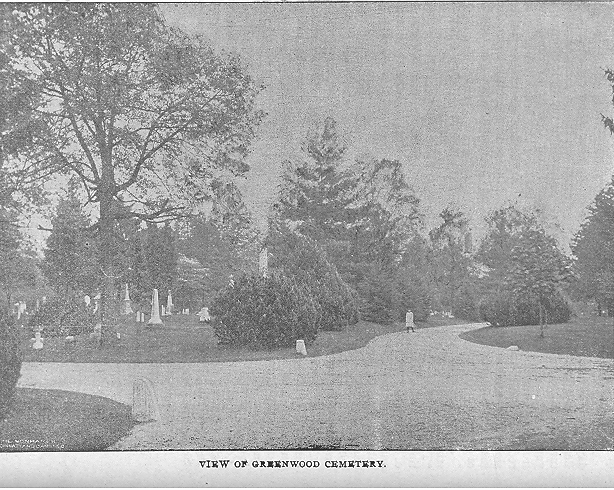
THE CENTENNIAL, ANNIVERSARY OF HAMILTON, O. - 221
HAMILTON IN THE WARS.
BY HENRY L. MOREY.
HAMILTON was a Fort before it was a village. Its location as so often happens, was alike favorable for a fortress and a city. Given a theatre of war in Northwestern Ohio, with a base at Cincinnati, the open gate-way of the Mill Creek Valley will make Hamilton an important military station.
FORT HAMILTON.
On Sept. 17th, 1791, a detachment of Gen. St. Clair's army under the command of Col. William Darke, reached the banks of the Miami River near this city, in its march against the hostile Indians. They encamped on the prairie below the city, until the arrival, a day or two afterward, of Gen. St. Clair, who had been detained at Fort Washington; upon his arrival the site of the fort was selected and the work of erection began. According to the most authentic accounts the fort was located on the river bank, and extended from Market street south to the site of the United Presbyterian Church, at the corner of Court and Water streets. The work was a stockade, whose walls were about one thousand feet long, with bastions, store-houses, magazines and barracks for the officers and men. The magazine was made of squared timbers, and stood near the site of the present United Presbyterian Church. Having served its warlike purpose, it was for many years after the organization of Butler county, used as the county jail. The officer's mess room, which was located near the corner of Front and High Streets, was a commodious frame building, perhaps the most pretentious in the fort. Like the powder magazine, its purpose in war having been served, it was used for some years as the court house, occasionally for religious services and other public meetings.
No unusual incident attended the building of the Fort. On its completion it was named Fort Hamilton, in honor of Alexander Hamilton, the distinguished Secretary of the Treasury.
On the 4th of October 1791, St. Clair, leaving a small force under Capt. John Armstrong to garrison the Fort, set out with his little army of 2,300 men, upon his campaign which ended thirty days later in the disaster at Fort Recovery.
They forded the Miami River at a point a little north of the present junction railroad bridge, and marched over the hills in a northerly direction. The names of the creeks, Two Mile, Four Mile, Seven and Ten Mile, indicate the distance from Fort Hamilton, at which the army crossed each of them.
222 - THE CENTENNIAL ANNIVERSARY OF HAMILTON, O.
Gen. Harmer had warned St. Clair that his defeat was certain; and no wonder. The army had been hastily thrown together. It lacked dicipline, coherency, Commissary and Quartermaster supplies, and indeed all thing, necessary to efficiency, and so rushed to destruction, Gen. Wayne afterward required three years to accomplish what Gen. St. Clair undertook in as many months. A few days before the fatal battle, a large body of the militia deserted, and Col. Hamtranck with the best regiment, was sent back to protect the supplies from being plundered.
The army reduced to 1300 men was attacked at daylight Nov. 4, 1791, and before 10 o'clock, a slaughter rarely equaled took place.
Thirty-eight commissioned officers were killed on the battlefield and thirty-one were wounded, and five hundred and ninety-three private soldiers and non-commissioned officers were killed, and two hundred and fourteen wounded. Among the officers killed was Gen. Richard Butler, in whose honor Butler county is named. On November 6th, 1791, Gen. St. Clair reentered Fort Hamilton with the remnant of his army, and on the 8th day of the same month, they marched to Fort Washington, at Cincinnati. The advance from Ft. Hamilton required thirty days, the retreat was accomplished in two days
Until the spring of 1793, Ft. Hamilton remained under the command of Capt. Jno. Armstrong of the regular army of the United States. He had served under Gen. Josiah Harmar, in 1790, in his expedition against the Northwestern Indians. He had proved himself in that service to possess great courage, endurance and resources. He seems also to have been unusually systematic and careful. He kept a diary during the campaign,. which has afforded valuable historical material for later writers.
On the 7th of October 1793, Gen. Wayne began his march from Cincinnati, and on the next day reached Ft. Hamilton. Fully warned by the failures of Harmer and St. Clair, Gen. Wayne had made the most complete arrangements for a vigorous and conclusive campaign. He would accept no short enlistments, and refused to move until his Commissary and Quartermaster's department had been made completely efficient. His troops had already been drilled for more than a year in all the evolutions necessary for Indian warfare. During the autumn and winter of 92-93. they had been in camp at Legionville, 19 miles below Pittsburg ; and the summer and early autumn of 93 had been spent in the neighborhood of Cincinnati. Nothing had been omitted to give the highest efficiency to his famous legion, and every movement was made by him with a deliberation and care, which indicated that he had come to stay. On the 9th of October he moved from Ft. Hamilton, but proceeded by a different route from that of St. Clair. He crossed the Miami river above the town of Hamilton, and for the most part followed the valley of the Seven Mile Creek to Eaton. It was not until the 20th of the following August, that he fought the decisive battle of "Fallen Timbers," which broke the Indian confederacy, and secured to the United States the undisputed
THE CENTENNIAL ANNIVERSARY OF HAMILTON, O, - 223
possession of the northwestern frontier. A year later, namely August 3d, 1795, a treaty was made at Greenville which terminated forever the most formidable Indian conspiracy that has ever confronted the United States.
From this period forward, the military use of Fort Hamilton ceased, and the Fort was abandoned.
Capt. John Armstrong was succeeded in command by Major Michael Rudolph. He seems to have been a harsh and severe commander, and has an unfavorable report in the history and tradition of those times. Among other things he is remembered for causing the execution of three deserters, whose pardon had been issued by Gen. Wilkinson, but had not been received at the Fort. It was felt that he had eagerly hastened the executions, in order to arrest the tendency to desert, which has always manifested itself so strongly in the army upon our frontiers. It is even said that he choosed to resign rather than stand his trial before a court-martial. Tradition has it that he returned to Virginia, and that subsequently he was captured and hanged by Algerine pirates. Between the defeat of St. Clair and the advance of Wayne's army, there were occasional murders by the Indians in the neighborhood of Fort Hamilton, but nothing that could be dignified with the name of a battle. On the 17th of December 1794, only five months after the victory of Gen. Wayne, the town of Hamilton was laid out and opened for settlers.
Upon the advance of Wayne's army in 1793, Major Johnathan Cass, the father of the distinguished statesman and orator of Michigan, Gen. Lewis Cass, was placed in command of the Fort, and so far as is known he so continued until the fort was abandoned. Many of the soldiers of the armies of St. Clair and Wayne, and of those who were employed in connection with the armies, settled in Hamilton and vicinity and formed an important element of the early society. Among these a few were so conspicuous as to merit notice in this brief history.
John Riley had been a soldier in the war of the revolution, and, when a mere boy, had participated in the battles of Guilford Court House, Camden and Eutaw Springs. He was a teacher in Columbia, now part of Cincinnati, but was one of the volunteer force that went to the scene of St. Clair's defeat in January 1792, to bury the dead,—that were abandoned upon the battle field. The weather was intensely cold and deep snow lay on the ground, so that the work was imperfectly done. In 1803 Mr. Reily settled in Hamilton, where he lived until his death in 1850. He filled numerous positions of public trust, and is remembered for his strong individuality, his high sense of honor, and his fidelity to every engagement and obligation. In these respects no man in the county has ever excelled him.
Brice Virgin who was Captain of the volunteer company formed at North Bend for burying the dead at Ft. Recovery, settled at Princeton in this county, and spent his life there.
224 - THE CENTENNIAL ANNIVERSARY OF HAMILTON, O
Thomas Irwin who was a soldier in Gen. Harmer's expedition of 1790, and also in St. Clair's army, afterward settled in Middletown where he died in the year 1847. He was also a soldier in the war of 1812.
Joel Collins who served in the Indian wars and served as Captain in the army against Great Britain in 1812–I4, settled at Oxford, where he died in the year 186o, at a very advanced age, after an honorable and useful life.
Isaac Paxton was a soldier of Gen. Wayne's army, serving three years, and afterward lived in Hamilton where he died in 1861. The brothers, Robert and Wm. McClellan, were typical pioneers ; and Robert especially lived a life of continuous adventure and danger. He was one of the famous scouts of Gen. Wayne, and one of the party of Lewis and Clark, that crossed the Rocky Mountains in 1804. He never seems to have settled anywhere. until age and infirmity compelled him to ceace his roving and adventurous career. His adventures form one of the romances of frontier life. He is perhaps the most striking figure in the lives of the Pioneers by McDonald and McBride, and he has been immortalized by Washington Irving. William McClellan settled at Hamilton, and for eight years was Sheriff of Butler county, where he died in the year 1827.
Brigadier John Wingate died near Symmes Corner in the year 1851. He came to the western country with Gen. Wayne's army, took a brave and conspicuous part in the battle of Fallen Timbers, and after the treaty of Greenville returned to Fort Hamilton and settled there. He served in the war of 1812 against Great Britain.
Matthew Hueston and John Sutherland were both connected with the Commissary Department of Wayne's army. After the close of the Indian wars, they both became citizens of Butler county, where they spent the remainder of their lives.
The following list of names of soldiers buried in Greenwood cemetery is taken from the history of Butler county
Soldiers of the Revolution and Indian Wars—Isaac Hammond was in the battle of Brandywine.
John Reily—Eutaw Springs, Camden and Guilford Court House.
Pierson Sayre, John Wingate.—Revolution and Indian Wars.
Joseph McMaken, Isaac Hull, William McClellan, and John Sutherland,—Indian Wars.
Soldiers of 1812—Robt. Rosencrans, Jacob Garver, John G. Rosebone, John P. Reynolds, John Pierce, Thomas Stone, Isaac Falconer, John Caldwell, Matthew Hueston, Capt. John Cleves Symmes, Capt. Abner Torbert, Dr. Dan'l Millikin, Wm. H. Wilcox, Vincent Cohee, William Clements, John Freeman, John Byers, Edward Brown, William Dye, Alexander Delorac, Alexander Smiley, John Vinnedge, Samuel Millikin, Wilkins Warwick, Thomas Sinnard, Dr. Jacob Lewis, N. S. Smith, F. Perry, Robert Clements John Woods, Isaiah Vale, Isaac Paxton, William Shirley, John Crane, James
THE CENTENNIAL ANNIVERSARY OF HAMILTON, O. - 225
B. Thomas, Frederic Devou, Major James Patchell.
THE MEXICAN WAR.
Two companies were formed at Hamilton to answer to the call of President Polk upon the state of Ohio, for three regiments, as its quota in the war with Mexico. Appeals for volunteers were made at a public meeting, and in one day a company was enrolled, and went into camp in the sycamore grove, which then skirted the river below the present Junction Railroad.
John B. Weller who had served in Congress from 1839 to 1845 was chosen Captain. James George who became Colonel of the 2nd Minnesota in the war of the Rebellion was chosen First Lieutenant, and Oliver Weatherby Second Lieutenant. They went direct by the canal to Camp Washington, and were attached to the First Ohio Regiment, as Company I. In the organization of this regiment, Captain Weller was made Lieutenant Colonel. First Lieut. George was advanced to Captain, and Second Lieutenant Weatherby to First Lieutenant; William Wilson was elected Second, and Johnathan Richmond, Third Lieutenant. Ferdinand VanDeveer, who became a Brigadier General in the war of the Rebellion now the Judge of our Common Pleas Court, was appointed Orderly Sergeant.
The following observation is found in a local history.
"Company I contained about thirteen young lawyers of this city and it was said by a local wag, that during their absence, Hamilton was more peaceable than it had ever been before."
Upon its organization and equipment, the First Regiment was ordered to New Orleans. Here it encamped on the field where the British were defeated by Gen. Jackson in 1815. From there they embarked for the hostilty shores of Mexico, and landed at Brazos Santiago at the mouth of the Rio Grande.
From there they joined Gen. Taylor, on the march to Monterey. Lieutenant Wetherby having resigned, Sergeant Van Deveer was chosen to fill the vacancy.
This company participated in the battle of Monterey, Sept. 19, 20, and 21st, 1846. Captain George was wounded in this battle and resigned, and Lieut. VanDeveer was elected to his place, and commanded the company during the remainder of its service. A dozen members of Company I were wounded at the battle of Monterey, and three, John Pearson, Oscar Brehme and Samuel Freeman were killed, and their bodies now rest in one grave in Greenwood Cemetery.
This Company, known as "Butler Boys No. 1," at the expiration of its service, was received with every manifestation of joy by the people at home.
Its only survivor is its distinguished Commander General and Judge Ferdinand VanDeveer,—Col. Weller died in New Orleans in 1878.
Another Hamilton Company for the Mexican War, known as Butler Boys No. 2 was recruited by Capt. Wm. P. Young, and attached to the
226 - THE CENTENNIAL ANNIVERSARY OF HAMILTON, O.
Fourth Regiment, commanded by Col Brough, brother of John Brough, who was Governor of Ohio during the War of the Rebellion Capt Young became Major of the Regiment on its organization. They went by river to New Orleans and thence to Metamoras, and Vera Cruz, and took an honorable part in the war. On their return home at the end of their service, they were welcomed with demonstrations of joy in the various localities from which they had enlisted.
The following soldiers of the Mexican War were buried in Greenwood Cemetery at Hamilton
Daniel McCleary, William D. Young, Joseph H. Garrison, Wiliam H. Sinnard, William H. Wilson, James Lenahan is buried in the Catholic Cemetery below Hamilton. John Holloway, Oscar Boehme, J. S. Freeman, John Pearson. The last three named in one grave. John G. Denzer, James Moore, Cicero Birch, John L. Wilkins, Peter Leflar, James B. Millikin.
When the assault on Ft. Sumpter was announced, the people of Hamilton, without distinction of party responded with a zeal and unanimity that placed them in harmony with t~: e loyal states. Upon the receipt of the President's proclamation calling for 75,000 volunteers, a meeting was held, speeches made, and resolutions adopted, expressive of serious and determined patriotism.
Two regiments were recruited and organized at Hamilton : the Thirty-fifth and sixty-ninth, and a large number of detachments went out into other regiments, or performed independent service. The first company organized was the Jackson Guards, under Capt. J. B. Bruck, which was attached as Company K. to the First Ohio Regiment, and which was organized as early as April 18th, 1861. The Hamilton Guards was organized by Capt. Rossman and went to Columbus on the 21st, and became Company F. 3d. O. V. I. The University Rifles, composed mostly of students of Miami University, enlisted for three months, and commanded by Capt. Ozro J. Dodds, were encamped on the Fair Grounds at Hamilton for a short time before going to the front.
The Butler pioneers under Capt. Wm. Smith, and an Infantry Company under Capt. Humback, and the Hamilton Rifles under Capt. W. H. Miller, were rapidly recruited, and accepted in the United States service. About forty German citizens of Hamilton became members of Company B. 9th Ohio Regiment at Camp Harrison. A cavalry company was recruited at Hamilton by Minon Millikin, who afterwards became Colonel of the 1st Ohio Vol. Cavalry, and an Infantry Company by Capt. John I. Earhart. An organization was formed of young mere from fifteen to nineteen years old, known as the Young Guard, A Military Company was formed by W. H. H. Russell and others which drilled at Jacob's Hall.
The "Reeder Cadets," consisting of young' men fifteen to eighteen years
THE CENTENNIAL, ANNIVERSARY OF HAMILTON, O. - 227
old, was organized by Capt. Nathaniel Reeder, and officered as follows : Charles Potter, Captain; Thomas Shaffer, First Lieutenant: F. A. Lighter' Second Lieutenant; and Joseph Wyman, Orderly Sergeant.
Dr. Mallory began raising a company and had forty-two names enrolled. Chas. H. Murray also engaged in recruiting a cavalry company, and the military spirit became general among the people.
The thirty-fifth Regiment was composed largely of Hamilton men, and almost entirely of Butler county men. The following is a list of its regimental officers : Col. Ferdinand VanDeveer; Lt. Cols. Chas. L. H. Long, Henry V. N. Boynton; Major Jos. L. Budd; Adjutants, Geo. B. Wright, John VanDeveer, James F. Harris; Surgeon, Perkins A. Gordon; Asst. Surgeons' Francis D. Morris, Chas. A. Wright, A. H. Landis; Chaplain, John Woods.
This regiment was engaged in the battles of: Corinth, Miss. ; Siege of Perryville, Ky.; Tullahoma—Campaign, Tenn; Chicamaugua, Ga.; Mission Ridge, Tenn.; Bussard Roost, Ga.; Atlanta Campaign, Ga. ; Dalton, Ga. ; Resaca, Ga. ; Kenesaw Mountain, Ga. ; Pine Mountain, Ga.; Pine Knob. Ga.; Kenesaw Mountain, (General Assault) Ga.; Peachtree Creek, Ga.
The sixty-ninth Ohio Regiment was also organized at Hamilton. It entered the service in the early part of 1862, and was assigned to provost duty in Tennessee, under Andrew Johnson, then Military Governor of that state.
Its first Colonel was Hon. Lewis D. Campbell, who resigned on August 9th, 1862, and was succeeded successively by Colonels W. B. Cassilly and M. F. Moore.
It had other Regimental Officers as follows: Lt. Cols. Chas. L. Gano, Geo. F. Elliott, J. H. Brigham; Majors, Eli J. Hickox, Jas. L. Hanna, Lewis E. Hicks; Adjutants, Richard H. Cunningham, W. S. Mead. Thos. B. Hoffman, Joseph W. Boynton ; Regt. Quartermasters, Fred B. Landis, Levi E. Chenoweth.
This regiment took part in the following battles: Gallatin, Tenn.; Stone River, Tenn. ; Mission Ridge, Tenn. ; Resaca, Ga. (including Punkin Vine Creek;) Kenesaw Mountain, Ga. ; Marietta, Ga. ; Chatahoochie, River, Ga.; Peach Tree Creek, Ga. ; Atlanta, Ga. ; Siege of Jonesboro, Ga.; Bentonville, Ga.; Sherman's March to the Sea.
Many citizens of Hamilton enlisted and served in other organizations, a considerable number in the 5th Ohio Cavalry, and in the 83rd and 93rd Ohio Regiments.
The Morgan Raid called into existence a number of Hamilton organizations for the purpose of resisting the invasion of our state.
The capture of Gen. Morgan is an honor that has been warmly contested, but it has not been successfully disputed that the honor rightfully belongs to our townsman Major Geo. W. Rue of the 9th Ky. Cavalry.
The surrender of Lee, the fall of Richmond, and the end of the great rebellion, was celebrated in Hamilton with great rejoicings.
The military spirit of the people has been maintained.
228 - THE CENTENNIAL ANNIVERSARY OF HAMILTON, O.
Such military bodies as are usual in times of peace have been organized.
Light Infantry Companies and Companies of the Ohio National Guards; have existed here in a high state of dicipline and drill.
The Juvenile Cadet Corps, an organization of boys from seven years up, has attained great proficiency in marching and drill, and has acquired a widely extended reputation.
The Grand Army of the Republic, the Sons of Veterans, and their kindred organizations, the Woman's Relief Corps, and Woman's Aid Society, are all in a flourishing condition.
The sentiment of patriotism is inculcated in our children, and it needs only public peril to call them to arms in defense of their country and her institutions. Let us hope that they may be as conspicuous for their civic virtues, as their fathers have been for military services.
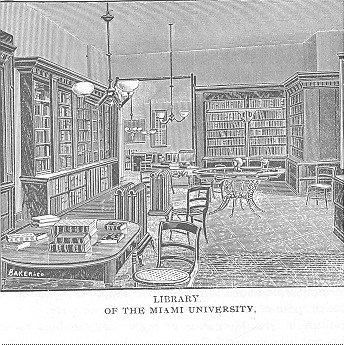
THE CENTENNIAL ANNIVERSARY OF HAMILTON, O. - 229
STATESMANSHIP AND POLITICAL INFLUENCE.
BY W. H. HARR.
IN point of political influence and statesmanship, the citizens of Hamilton during the past one hundred years have exercised their full share as compared with the people of other communities of like size in this state. In the Constitutional Convention of 1802, John Reily was a member from Hamilton County, the territory constituting the County of Butler then forming a part of Hamilton County. In the Constitutional Convention of 1851, Elija Vance was a member and acted as one of the Vice Presidents, and in the Constitutional Conventional of 1873, Lewis D. Campbell was a member and Vice President. Vance and Campbell were respective able delegates and very influential in the deliberations of the bodies of which they were members.
John Woods, Taylor Webster, John B. Weller, Lewis D. Campbell, Henry L. Morey and James E. Campbell, citizens of Hamilton, have represented the Congressional District in which Hamilton is situated, in Congress and have exerted a Lull share of influence upon National Legislation. It will not be insidious to say that during the controversy concerning the repeal of the Missouri compromise, and the exciting legislation immediately preceding the rebellion. Few, if any men in Congress, stood superior to Lewis D. Campbell. He was abreast of such eminent patriots as Thadeus Stevens, Anson Burlingame, Benj. P. Wade, and Zachriah Chandler. The terms of the several members in Congress were as follows : John Woods, four years ; Taylor Webster, two years ; John B. Weller, six years; Lewis D. Campbell twelve years; Henry L. Morey, six years; James E. Campbell, six years; John B. Weller and Lewis I). Campbell each served as Minister to Mexico. Wm. Bebb and James E. Campbell each served one term as Governor of the State. John Woods served as Auditor of the State for the period of six years to the general approval of the people and to the great benefit of the State. The system of accounts established in the Auditor's office by him have never been changed, the same having been found adequate to the increased demands of that department. Mark C. McMaken now living an honored life at 92 years of age. Joseph J. McMaken his son, Lewis D. Campbell, Thos. Moore, William H. Campbell, Neal C. McFarland, E. G. Rathbone and Jas. E. Neal have at different times been members in high standing of the Ohio Legislature, the latter attained pre-eminence in the speakership of the house of Representatives.
John M. Millikin, served with great credit one term as Treasurer of State.
230 - THE CENTENNIAL ANNIVERSARY OF HAMILTON, O.
In the days of the old Whig and Democratic Parties, the Hamilton Inelligencer newspaper under the editorship of John Woods and Lewis D. Campbell was a party organ of much power and extended political authority.
It would be beyond the purpose of this article to enter into detail more ully touching the statesmanship and political influence of citizens of Hamilton during the past, nevertheless it is not out of place to say in this connection that the people of no city of equal size in the state can be said to have exerted so much authority over legislation and over the selection of candidates for important public offices as have the party representatives residing in this city. Many of those capable of exerting the most political power in emergencies, have never been candidates and have therefore been able to act independently, and free from selfish motives, and acting alone from patriotic considerations, have wielded an influence far greater than could otherwise have been the case.
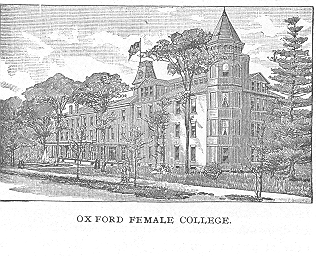
PARTY V.
HAMILTON
- ITS -
Transportation Facilities, Manufactures
Etc.
HAMILTON, OHIO.
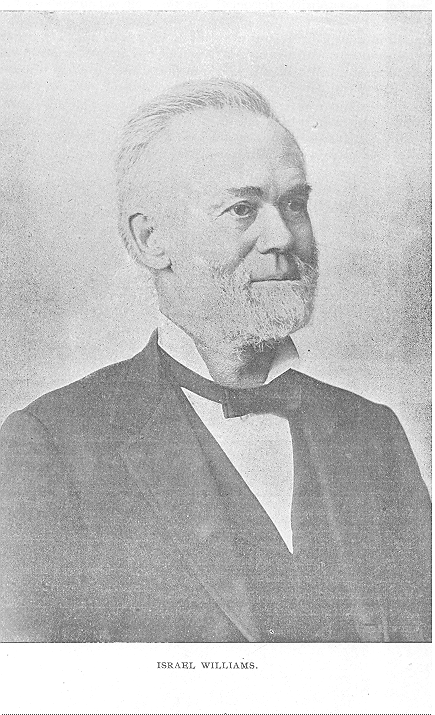
THE CENTENNIAL ANNIVERSARY OF HAMILTON, O. - 233
HIGHWAYS, RAILROADS AND CANALS.
ISRAEL WILLIAMS.
AMONG the advantages that a community may be possessed of are the methods of travel in going to and from, and the means of transportation of commodities to be acquired and those to be disposed of by the people.
In these respects the city of Hamilton should be regarded as very favorably situated.
All of the country roads leading into the city are turnpikes, affording the most convenient and ample means of neighborhood travel and traffic. The Miami and Erie canal which connects the city of Toledo on Lake Erie with the city of Cincinnati on the River Ohio, affords an excellent means of transportation of freight to those cities and intermediate points. On account of the cheap rates of freight charged to shippers on the canal, it has an important bearing upon the charges of freight made by competing railroads. The existence and continued usefulness of the canal is almost of vital importance to the local business interests of our citizens.
The railroad facilities are extraordinary, they consist :
1st. The Great Pan Handle system, comprising upwards of 7,000 miles of road under control of one management and permeating every portion of the United States, and with direct connections with means of communication to all parts of the Commercial world. The great main line of the company's road leading from Cincinnati to Chicago passes through Hamilton, and hence it can be correctly said that we are brought through this means in touch with all the civilized world.
Secondly: The Cincinnati, Hamilton & Dayton Railroad system while lacking the vastness in mileage possessed by the Pan Handle, is in its local bearings upon the interests of our citizens of more direct importance than even the Pan Handle. Between this city and Cincinnati, there are twenty-three passenger trains daily. This company with headquarters at Cincinnati has independent lines leading by way of Hamilton to Toledo, Chicago and St. Louis and intermediate points, with connections with other lines, notably the Big Four, Baltimore and New York Central and Erie systems, all parts of the United States and beyond.
By the means aforesaid, our citizens have every facility for travel and the transportation of commodities that can be desired or utilized by an intelligent and enterprising community.

THE CENTENNIAL ANNIVERSARY OF HAMILTON, O. - 235
BUSINESS OTHER THAN MANUFACTUR.
BY P. G. BERRY.
HAMILTON, with its transportation facilities and its close proximity to Cincinnati, has within the last twenty years, developed large commercial and financial interests, and, while at an early time in its history, its being so near Cincinnati was deemed a detriment to its growth, this seeming drawback has since proved to be one of its chief aids to prosperity, in that it attracts business interests, which a large city, on account of scarceity of room, is unable to retain and at the same time affords a close market for its products.
The increase in the business interests of Hamilton during the past twenty years, has been study and substantial. There has been no "boom"' and everything indicates a still greater increase in trade in the future.
There are Eighteen Dry Goods stores in Hamilton, doing a yearly business of between $600,000 and $700,000.
There are three National Banks each doing a prosperous business and each having a capital of $100,000.
There are four Building and Loan Associations with an aggregate capital of $4,000,000. By their aid many have been enabled to own their homes in Hamilton, who would not otherwise.
There are published in this city, Two Daily, Three Weekly and Two Monthly newspapers and One German Weekly newspaper.
There are Eighteen Churches, viz: one Baptist, one Episcopal, one Evangelical German Protestant, one Jewish, one Lutheran, Three Methodist Episcopal, two Presbyterian, one Reformed, three Roman Catholic one Universalist and two United Brethren.
There is a free circulating library, with upwards of 6,000 volumes and the number steadily increasing each year. Here can be found all the latest works of History, Travel, Fiction, &c., together with the leading magazines and newspapers of the country.
Hamilton has two organized brass bands, noted for their excellent music. two singing societies, two medical societies and a bar association.
There are eight miles of Electric Street Railway, furnishing rapid transit to all parts of the city.
Five patent medicine companies assist the doctors in relieving suffering humanity.
The bar is composed of forty-nine attorneys, who in ability, honesty and
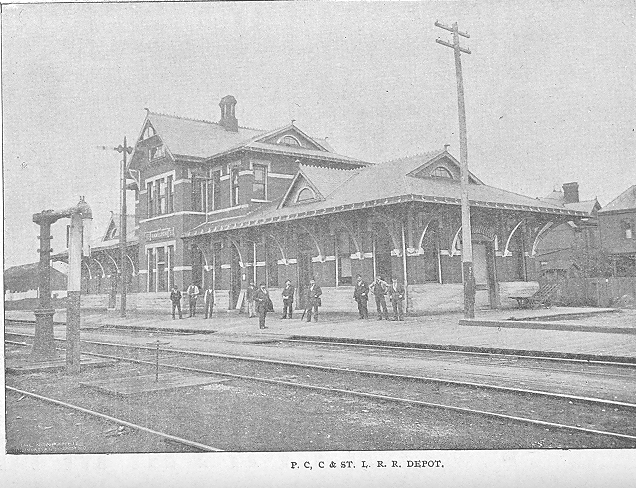
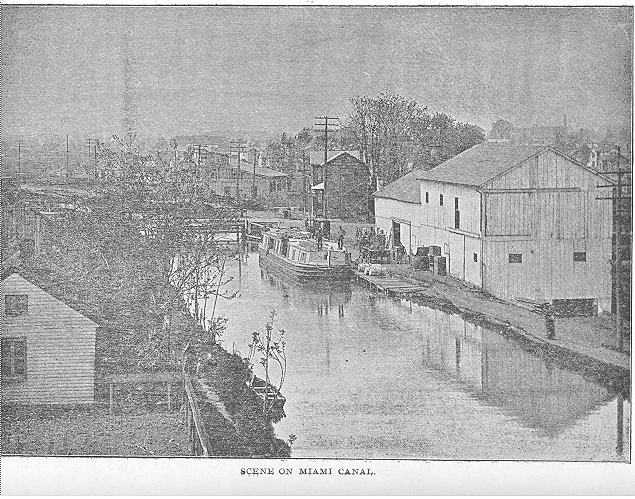
THE CENTENNIAL ANNIVERSARY OF HAMILTON, O. - 237
careful attention to business, are the peers of any in the State and are a credit to our city. They manage to take care of the property rights of our citizens, while twenty-seven eminent physicians with the aid of eleven druggists take care of our bodily ailments.
There are six undertakers in Hamilton, all doing well.
Our city has for many years been noted for furnishing the best domestic cigar in the country. The yearly sales in the city, by fifteen dealers and manufacturers being over $2,500,000.
Eighty-three dressmakers and fourteen tailors with the assistance of eight milliners, eight hatters and thirty-seven shoe dealers managed to keep us clothed.
Eleven hotels, twenty-six boarding houses, thirteen restaurants and ninety-eight saloons furnish refreshments for the inner man.
Eighteen real estate agents are ready at any time to sell you cheap property, while only thirteen agents can give you insurance.
Of other industries in Hamilton, there are the following
Barber shops, . . 20.
Bakeries, . . . 15.
Basket mfg's . .2.
Beer bottlers . . 3.
Auctioneers . . 1
Bending factories . 2.
Blacksmith shops . 15.
Book binders . . 2.
Booksellers and Stationers . . 9.
Brick layers . . 6.
Brick manuf's . . 5.
Business colleges . 2.
Carpenters and Builders . . 19.
Carpet weavers . 7.
Carpet dealers 5.
Clothiers . . . 6.
Clothing renovators 3.
Coal dealers . . 10.
Confectioners . . 6.
Contractors . . . 8.
Daily Market . . 15.
Dentists . . . . 7.
Feed stores . . . 6.
Florists . . . . 3.
Furniture dealers . 6.
Furnishing Goods . 12.
Gas fitters . . . 3.
Hardware dealers . 4.
Ice dealers . . . 2.
Steam laundries . 3.
Live stock dealers . 4
Livery stables . . 11.
Locksmiths . . . 2.
Lumber dealers . . 10.
Malsters . . 4.
Marble works . 4.
Mattress mfg'r . 3.
Music teachers . . 12.
Painters . . . . 9.
Paper hangers . . 4,
Photographers . . 5,
Piano dealers . . 2.
Plasterers . . . . 3.
Plumbers . . . . 3.
Pump Dealers . . 6.
Roofers . . 3.
Harness dealers . . 5
Slaughter houses . 4.
Stoves and tinware, 7.
Wagon makers . . 9.
Jewelers . . . . 5.
Wood dealers . . . 6.
Nearly every industry is represented in Hamilton. They all seem to prosper. Everybody appears to be contented and while our city can get along very well as it is, there is room and a hearty welcome for all others who may wish to dwell with us.
There are three wholesale and eighty-six retail grocers, the retail.
The fruit and berry trade in Hamilton has assumed increased propor-grocers alone, doing a business of upwards of $500,000 yearly.
HAMILTON'S MANUFACTURES
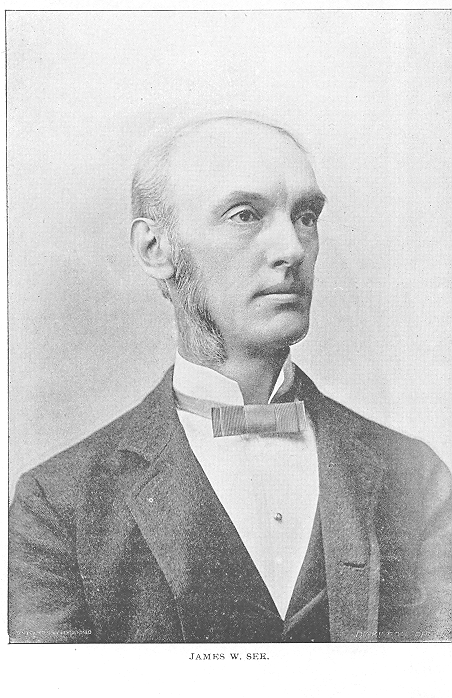
THE CENTENNIAL ANNIVERSARY OF HAMILTON, O. - 241
MANUFACTURES OF HAMILTON.
BY JAMES W. SEE,
IN every community of people the wants of that community are supplied by the merchant who buys in quantities. But the results of this commerce effect no change in the character of material handled. The merchant buys from abroad and retails at home. He brings no income from abroad.
But certain articles of supply can not be bought abroad, but require to be manufactured to suit the wants of users. The shoemaker procures the leather and other materials and fabricates it into the shoe to fit the foot of his customer. The shoemaker is thus a manufacturer, and his art is a creative one. Under his creative hand material changes its form and value, and he gives existence to an article that before had no existence So also with the tailor, and the plow maker, and the wagon maker, an the blacksmith, and the carpenter. These manufacturers bring material from abroad and from it produce new things for home use. But they too fail to bring income from abroad.
But the manufacturer, whatever line he may be working in, may eventually find that the things that he makes are of such special merit that there is a demand for them away from home, and quite likely he will extend his business until we finally find him bringing material from abroad, manufacturing it into new articles, and sending the new articles abroad, thus finding his market away from home; and we may in the end find that the outside markets have become so extensive as to cause him to give no further special attention to the home market. As a hone manufacturer lie advertises in the home newspapers and posts his bulletins upon the local boards, but his market grows upon hint. He advertises in the newspapers of the world at large, and advances his banners of trade into all the marts of civilization.
There are many manufacturers in Hamilton, and the space at the command of the present historian is limited and the embarrassing question
242 - THE CENTENNIAL ANNIVERSARY OF HAMILTON, O.
therefore presents itself: where shall the line be drawn ? Shall this history concern itself with every manufacturer in Hamilton? If so the history is too big to be written. But the history must be written, and it has been determined that the line will be drawn to include only those manufacturing institutions whose principal market is away from home. It becomes the function of these establishments to send money abroad for raw material, put this material into newly created forms, and send the new creation abroad and bring back into the community much larger sums of money than were paid out for the material. This money is the profit of this community, and has built its streets, its houses, its public buildings, and has brought to it its population. This class of manufacturers creates the community, and the class of manufacturers not included in this history supply the local wants of this community but bring no money income from abroad. This history will therefore deal with those establishments whose principal market is found beyond the limits of Hamilton and beyond the limits of the county.
Having thus determined the scope of this history it is decided to deal with each manufacturing establishment separately. A survey of the general field exhibits a magnificent line of manufactures in metal, wood, paper and wool, and special satisfaction is found in the fact that the goods produced are of the highest order of merit. The markets of the world call for two distinct grades of articles, namely, those that are of the best, and those that are of the cheapest, regardless of quality. Both of these demands must be supplied, and each is equally respectable, but it is a matter of congratulation that full employment has been found for the industries of the town in producing articles of the highest grade. An example can not be called to mind of a Hamilton product seeking low grade markets.
Many of Hamilton's factories are of transplanted growth. The manufacturer located in the large city has been surrounded by an extensive local market and has cultivated it highly, and has limited his horizon by it. His factory being located upon expensive property in the large city, and being often many stories high his work was done at a great disadvantage, his factory could not be conveniently extended, and his workmen would necessarily be of the tenement-house class to a great extent. Being prevailed upon to establish himself in Hamilton his eyes become opened to some startling facts. His new and suited to his work ; it is capable
THE CENTENNIAL CELEBRATION OF HAMILTON, O. - 243
of unlimited extension ; all his expenses are low; his workmen all become property owners and live in their own homes. But the most startling fact remains to be noted. He has moved away from the local market of the large city which he so highly cultivated. He finds that instead of a home market he must seek a market abroad. He begins to study the map of the world, and is very much surprised to find how big it is; his horizon expands and he reaches out the tentacles of trade, and, instead of wasting his energies upon a local market, he finds himself independent of all special localities, and finds his goods reaching the ends of the earth. His business may grow to an extent without limit and lie finds himself entirely independent of embarrassing local depressions in trade. He advertises abroad, and his goods become known throughout the length and breadth of the land. This is the true history of every manufacturer in Hamilton who has removed from a large city.
Another fact should be noted regarding the manufacturers located in Hamilton. There is no unfriendly competitive strife. Two manufacturers :striving for supremacy in a local market are apt to have their personal relationship strained, but when the whole world becomes the market the fact is soon established that the world is big enough for peaceable and friendly work by all.
The success of Hamilton's factories is not due to the money that has been put into them, for money itself contains no element of successful venture; nor is it due to the brain of the capitalist who controls the money and operates the factory, for a successful marketable produce is not the mere result of capital and of brain in managing that capital ; nor is it due to the salesman who makes the market for the product, for there must be the product before there can the sale; nor is it due to the designers and inventors and engineers who contrive the product, for the most meritorious product will fail if not successfully disposed of; nor is it due to the mechanical skill of the workman, for such skill will always be idle if technical talent does not contrive things to be made, and business management does not provide the facilities for manufacturing and the facilities for getting the products upon the market. The success of Hamilton's factories is due to all of these things, to time splendid workmen, to the talented contrivers, to the magnificent business management and to the energetic salesman.
The success of individual factories, which will be pointed out in this history, awaits time newcomers. Hamilton locations, of superior advan-
244 - THE CENTENNIAL ANNIVERSARY OF HAMILTON, O.
tages, are at the immediate disposition of enterprising manufacturers who desire to increase their facilities, better their workmen, improve their product and extend their trade, and the present manufacturers of Hamilton stand ready to welcome them with the right hand of fellowship and the record of experience and success.
It is of interest to note the diversity of products of Hamilton's factories, and the tendency of these products toward the formation of a complete economic system. An example may be found as you peruse the morning newspaper. The paper on which this newspaper is printed is made in Hamilton. The paper-waking machines which fabricated the paper were made in Hamilton. The machinery which made the ink with which the printing is done was made in Hamilton. The engines which furnished the steam power for making the paper and for running the presses were made in Hamilton. The boilers which furnish the steam for the engines were made in Hamilton. The boiler-making machinery employed in making the boilers was made in Hamilton. The steam pumps which supply the boilers with water were made in Hamilton. The saw-mills that produce the Limbers of the paper mill and printing office were made in Hamilton; and the iron working machinery employed in making the printing presses, and the paper-making machines, and the ink-making machinery and the engines were made in Hamilton. Massive pumping engines for the water-works of cities are made in Hamilton. Treasure throughout the world is stored in safes and vaults made in Hamilton. The evening drive is taken in buggies from the buggy factories of Hamilton. The beautiful and artistic tiling which forms the mantel facing and the hearth of the home is made in Hamilton. The finest of woolen blankets are made in Hamilton. The running felts upon the paper-making machines are made in Hamilton. The furniture is made in Hamilton. The wood-working machinery employed in making the furniture and employed in making the buggies is made in Hamilton. The spring mattresses of the beds are made in Hamilton. The overalls of the workmen are made in Hamilton. The stoves in the kitchens and living rooms are made in Hamilton. The canned fruits and vegetables are made in Hamilton. The cans that contain these articles are made in Hamilton The laundry machinery is made in Hamilton.
THE CENTENNIAL ANNIVERSARY OF HAMILTON, O. - 245
THE WATER POWER OF HAMILTON.
THE Miami River, the Great Miami River, runs directly through the city of Hamilton, so also does the Miami and Erie Canal. There are two locks on the canal within the city, the surplus flow from which is utilized for power, one in running a paper mill and one in running a flour mill.
About 1843 a number of citizens, L. D. Campbell and John Woods being the leading spirits, determined to utilize in Hamilton the considerable fall of the river in the immediate neighborhood. Between four and five miles above the city a dart was erected and a canal was constructed leading from the dam to the city. A mile below the dam an impounding reservoir of nearly one hundred acres was provided. This is known as the Big Reservoir. Just within the city limits a reservoir was provided of about fifteen acres, and known as the Little Reservoir. From this little reservoir a canal was constructed about parallel with the river and running to Market Street, then called Stable Street. This canal constitutes the high level of the water power. Quite a number of manufacturing establishments are operated along this high level and take their water directly from this canal, discharging it into a tail-race which runs back to the river, starting back parallel with the canal, the city lying in a bend of the river. The fall from the high level canal, which is on Fifth Street, to this tailrace, which is on Lowell Street, is about twelve feet. In the northern part of the city, at Mill Street, a latteral arm was built to the canal, running west toward the river and then turning down along near the river, on Water Street, to Market Street. This canal furnishes power to factories located at various points along its length, the waste water discharging directly to short raceways leading to the river, the fall being about twenty-seven feet. From the end of the high level canal on Fifth Street a canal was constructed through Market Street to the river, and this canal furnishes the tail-race for powers located near the south end of the high level canal, the fall being ten feet. This Market Street forms also a. low-level power canal. At the river end of the Market Street tail-race other powers were supplied with a fall of about eighteen and one-half feet. These various canals in the city have been locally christened "Hydraulics," a word probably employed to distinguish them from the Miami and Erie canal. A stranger lost in Hamilton will be told that High Street is one block beyond the "hydraulic." This Greek is good local English
The canals or "hydraulics" are about forty feet wide and about four feet deep. No record has been found of the actual power of the system. About all of the power has long sago been taken tip, though some of it is not at present in actual use. The rates at which the power is sold, on leases, is extremely low, and the power is satisfactory. within its limits, except at certain seasons of the year. The power is leased by the "run," and about one-hundred runs are now under lease.
The water power is the property of the Hamilton and Rossville Hydraulic Company, of which Adam Laurie, Sr., is President; Asa Shuler, Vice: President, and E G. Rathbone, Secretary and Treasurer.
246 - THE CENTENNIAL ANNIVERSARY OF HAMILTON, O.
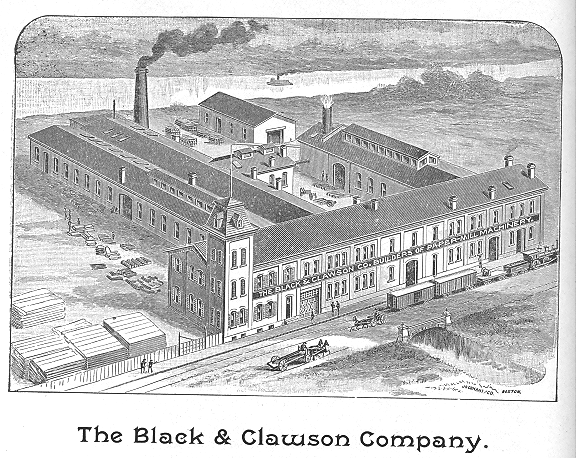
The Black & Clawson Company.
Paper Mill Machinery, Etc.
YOUNG FRANK BLACK had been knocking around his father's shop, and in 1866, he began his apprenticeship in the Owens, Lane & Dyer shop at one dollar per week. He then tramped and worked in Richmond, and then in the Whitely Reaper Works, Springfield, and then on the new
bridge at Louisville, and then in the Gates shop in Chicago. In Chicago he was getting three dollars per day. He wanted to learn how to run a roll-grinding lathe and found that he could get a job with the celebrated J. Morton Pool in Wilmington, Delaware, at one dollar per day. This was a hard rub but Frank stood to it and mastered the roll-grinding machine. In 1874 Peter Black & Sons got a J. Morton Pool machine and started the roll-grinding business in Hamilton, there being many paper-mills in the neighborhood needing such work. Frank operated the roll-grinding machine, and in May, 1874, the first roll-grinding was done in the Western country, a roll for Beckett, Laurie & Co. Peter, Black & Sons built a new shop on the corner
THE CENTENNIAL ANNIVERSARY OF HAMILTON, O. - 247
of Water and Market Streets. In addition to the roll-grinding they got. some extra work from the Owens, Lane & Dyer shop, which was overflowing with work, and a little repairing was done for paper-mills, the merest trifle..
Linus P. Clawson had been raised on a farm and knew nothing of machinery or of business, except that he had taken a course in a Commercial College. In 1875 Clawson got well of farming and immediately took the manufacturing fever. He came to town and found the Blacks, and just north of Black's shop Burns was making plows and wagons. Then the firm of Bnrns, Black & Co. was formed, consisting of P. Burns, John Conboy, Peter Black, Frank Black, I. P. Clawson and John Stillwaugh. The new firm bought the properties of Black and Burns, and the intention was to do roll-grinding and build agricultural implements. But this elaborate firm was too big to live, and in 1876 it was dissolved, Burns retiring to the northern part of the shop and assuming the wagon and plow business. The firm of Black & Clawson was formed, consisting of Peter Black, Frank Black and I. P. Clawson, to do roll-grinding. Roll-grinding was good business, but after all it was simply the operation of a single machine. Clawson was business. He had the hardest kind of business sense and an amount of pluck and energy which would make a success of anything susceptible of it. He made tip his mind that the firm of Black & Clawson should eventually become builders of paper-making machines. He was laughed at by the paper mill men generally, and his partners looked on in fear and trembling. The Rock dale mill was short of drying power, and Clawson proceeded to have designs made for super-dryers to improve the Rockdale mill. This brought pitying smiles from the Rockdale people, but Clawson hung on and got the order, and the job was done, and it was well done. This was in 1878, and was the first piece of paper-mill construction done by Black & Clawson.
At this time there were only two mills in the West making fine writing papers, and the Harding Paper Mill Company, at Excello, was making the best product. Their larger and finer mill at Franklin had burned and it was determined to r build it. That would require a Fourdrinier Paper Machine capable of producing the finest possible grades of paper. Clawson had the sublime nerve to go after this job, and Mr. Harding, a mail of splendid attain ments and rare good sense, was not long in taking Clawson's measure and in determining that the new machine should be built by Black & Clawson. When the paper-mill men of the valley heard of this they were astounded, and the prophets of evil held high carnival. But the machine was built and made paper, and it is making paper to-day of as fine grades as has ever been produced front the stock it works on.
Black & Clawson received about six thousand dollars for this job. The next year they rebuilt a cylinder machine for the Enson mill, near Springfield, and built an eighty-four inch cylinder machine for the Friend & Fox Paper Company, at Crescentville. They also built about one hundred of the Monarch Portable Engines for E. C. Hooven.
248 - THE CENTENNIAL ANNIVERSARY OF HAMILTON, O.
In this year they took up the manufacture of paper-pertorating machines of which there were very few in the United States, and those were imported machines. There were but two in Cincinnati. The Black & Clawson perforating machines are now in use all over the world, and no more of the English machines are sold here, and it is a very poor printing office indeed that has not a perforating machine. The manufacture of machines for making printer's ink was also taken up and vigorously pushed. These machines were sold all over the country and some have been sold iii Germany. It would be difficult now-a-days to read anything in print, which was not done in ink produced in the Black & Clawson machinery.
In 1881 the old shop proved entirely inadequate to the magnificent business which had been building up, so a new and very extensive shop was built at Second and Mill Streets. The concern was now better prepared for its work than anyone else in the world engaged in its line of manufacture. In 1883 the concern was incorporated, with a capital of one hundred and fifty thousand dollars, with Frank Black as President, and L. P. Clawson as Secretary and Treasurer. The capital has since been increased to two hundred and fifty thousand dollars. In 1886 Mr. Peter Black died. Mr. Black and Mr. Clawson both give constant attention to the details of the business which is constantly increasing. About one hundred paper-making machines have been built by this concern, and they stand to-day as the leaders in the trade, and the reputation of their machines is known the world over. These machines are to-day making paper of every grade, from tissue paper to pasteboard, and machines have been shipped to Australia, Japan, Canada, Mexico, France and Germany. Among the machines so far constructed is a one hundred and eighteen inch Fourdrinier machine for the Diamond Match Company, which is the largest Fourdrinier paper machine in the United States, and a one hundred and eighteen inch cylinder machine for the same concern, which is the largest cylinder machine in the world.
L. DEINZER & SON.
Manufacturers of Bent Wood Work.
IN 1855 Leonard Deinzer started a turning shop on Water Street, at the west end of Market Street. In 186t he was joined by John H. Stephan and the firm became Deinzer & Stephan, and hubs and spokes were added to the line of work. At that time Philip Hurm was running a bending factory in the same locality, and, in 1873, Deinzer & Stephan bought out Hurm and added his line of work to their business. In 1887 Stephan retired from the firm and took with him the hub and spoke part of the business. Mr. Deinzer now took in his son George, and the firm became L. Deinzer &. Son. They manufacture felloes, shafts, poles, bows, and bent work of every description for carriages and wagons, and the goody are sold throughout the ,country.
THE CENTENNIAL ANNIVERSARY OF HAMILTON, O. - 249
NILES TOOL WORKS.
Machine Tools.
THE carpenter's tools are the things which he takes in his hand to do his work with, and the machinery employed for accomplishing the same kind of work is called wood-working machinery. So, also, the small implements handled by the machinist are called machinist's tools, but the term iron-working machinery has never been generally adopted for the machinery which the machinists use. Such machines are known as "machine tools," and they comprise lathes, planing machines, drilling machines, slotting machines, boring machines, gear-cutters, and a host of other machines designed for operating on cold metals by the operation of a cutting tool removing a :shaving. Wherever machinery of any kind is built, machine tools are employed in doing the work. Machine tools are therefore machines to make machines and must possess fundamental accuracy. The accuracy and low cost of any kind of manufacturing in metal must therefore find its foundation in the accuracy and efficiency of the machine tools employed in the work. The production of machine tools involves the highest grade of skill in design and of workmanship in production.
In Cincinnati there was a large machine shop, originally owned by the Niles Brothers and called the Niles Works. It was engaged in general lines of mill work, steam engines, steamboat engines, locomotive engines, and heavy sugar machinery. It was a very old concern and had fallen behind the age. In it were employed two men, George A. Gray, Jr., and Alexander Gordon. They were old cronies and had long worked together, having hammered away on the Government gun-boats constructed at Cincinnati during the war. Gray was Scotch and Gordon was Irish, with a little scotch in his, too. Both were young men and good mechanics.
The Niles Works needed an additional lathe or two and found difficulty in getting the order filled by any of the builders of machine tools, and the lathes were accordingly built in the shop. After these were built a few more were built and sold to other shops, and soon a department was organized in one .corner of the shop especially for the manufacture or machine tools, and this department was called the Niles Tool `Works. Mr. James Gaff became interested in the matter and the result was the formation of the firm of Gaff, Gray & Gordon, calling their shop the Niles Tool Works, and taking the machine tool business of the Niles Works. The Niles Works went to decay and has faded from the earth, and the firm of Gaff, Gray S Gordon continued business a short time in a shop since torn down to make room for the Little Miami Depot. But the work was done tinder the serious disadvantages incident to a factory in a large city. Heavy work was done on upper floors and holes had to be cut in the wall to get big work out. In 1872 the firm moved to